Dementia Care Program: Self-Reflection and Clinical Analysis
VerifiedAdded on 2023/01/13
|6
|2479
|73
Report
AI Summary
This assignment report provides a comprehensive analysis of a Dementia Care Program, exploring various aspects of healthcare and nursing practice. Section 1 offers a self-reflection on the program, outlining its features and the student's suitability. Section 2 presents a clinical question, detailing immediate actions and assessments for a patient found on the floor after a seizure, including a hypothesis and actions with rationale. Section 3 focuses on prioritizing patient care, justifying the order of interventions based on the severity of each patient's needs. Finally, Section 4 addresses a conflict scenario between nurses, analyzing the causes of the conflict and proposing strategies for resolution, emphasizing patient safety and effective communication. The report incorporates relevant references and follows APA 6th edition guidelines.
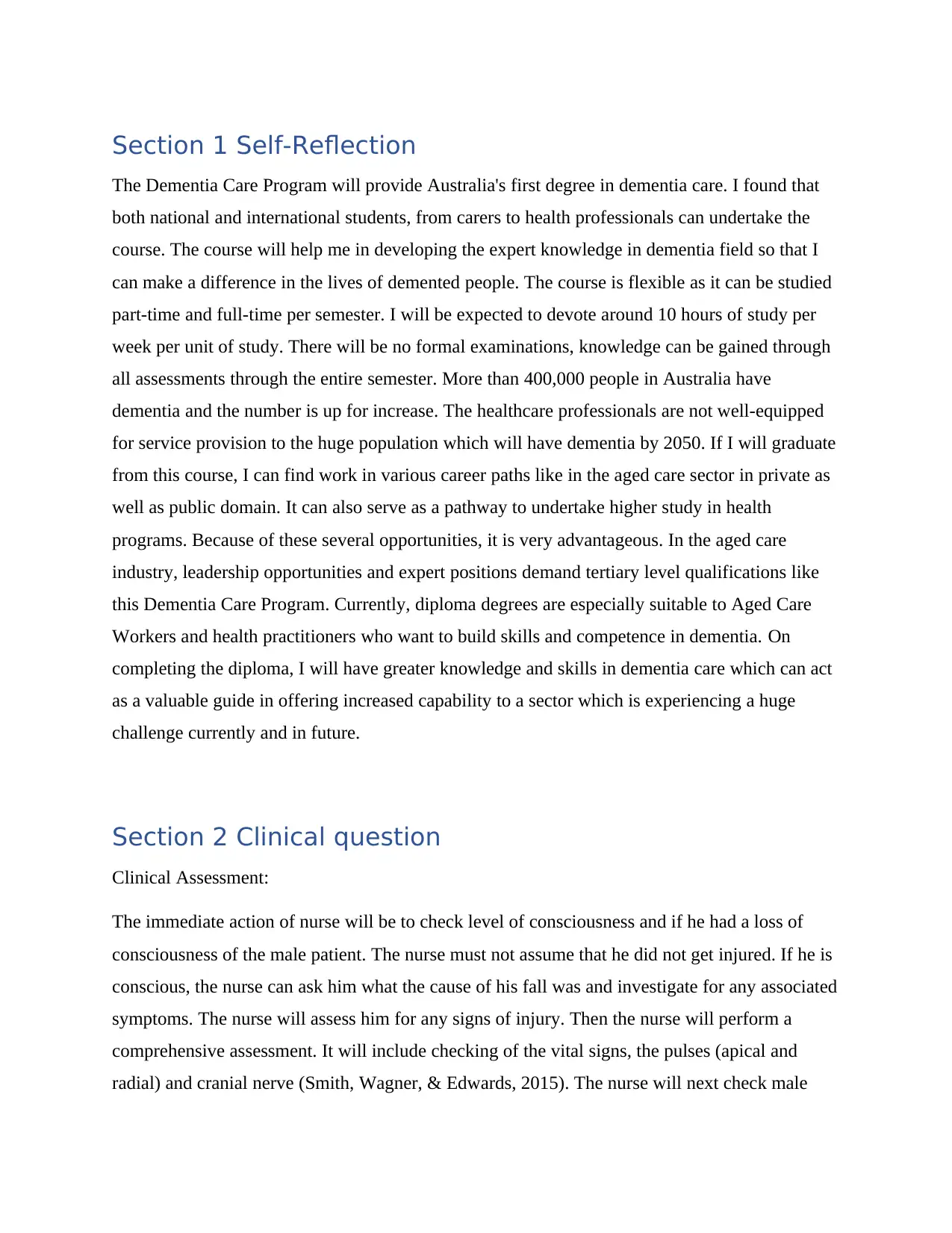
Section 1 Self-Reflection
The Dementia Care Program will provide Australia's first degree in dementia care. I found that
both national and international students, from carers to health professionals can undertake the
course. The course will help me in developing the expert knowledge in dementia field so that I
can make a difference in the lives of demented people. The course is flexible as it can be studied
part-time and full-time per semester. I will be expected to devote around 10 hours of study per
week per unit of study. There will be no formal examinations, knowledge can be gained through
all assessments through the entire semester. More than 400,000 people in Australia have
dementia and the number is up for increase. The healthcare professionals are not well-equipped
for service provision to the huge population which will have dementia by 2050. If I will graduate
from this course, I can find work in various career paths like in the aged care sector in private as
well as public domain. It can also serve as a pathway to undertake higher study in health
programs. Because of these several opportunities, it is very advantageous. In the aged care
industry, leadership opportunities and expert positions demand tertiary level qualifications like
this Dementia Care Program. Currently, diploma degrees are especially suitable to Aged Care
Workers and health practitioners who want to build skills and competence in dementia. On
completing the diploma, I will have greater knowledge and skills in dementia care which can act
as a valuable guide in offering increased capability to a sector which is experiencing a huge
challenge currently and in future.
Section 2 Clinical question
Clinical Assessment:
The immediate action of nurse will be to check level of consciousness and if he had a loss of
consciousness of the male patient. The nurse must not assume that he did not get injured. If he is
conscious, the nurse can ask him what the cause of his fall was and investigate for any associated
symptoms. The nurse will assess him for any signs of injury. Then the nurse will perform a
comprehensive assessment. It will include checking of the vital signs, the pulses (apical and
radial) and cranial nerve (Smith, Wagner, & Edwards, 2015). The nurse will next check male
The Dementia Care Program will provide Australia's first degree in dementia care. I found that
both national and international students, from carers to health professionals can undertake the
course. The course will help me in developing the expert knowledge in dementia field so that I
can make a difference in the lives of demented people. The course is flexible as it can be studied
part-time and full-time per semester. I will be expected to devote around 10 hours of study per
week per unit of study. There will be no formal examinations, knowledge can be gained through
all assessments through the entire semester. More than 400,000 people in Australia have
dementia and the number is up for increase. The healthcare professionals are not well-equipped
for service provision to the huge population which will have dementia by 2050. If I will graduate
from this course, I can find work in various career paths like in the aged care sector in private as
well as public domain. It can also serve as a pathway to undertake higher study in health
programs. Because of these several opportunities, it is very advantageous. In the aged care
industry, leadership opportunities and expert positions demand tertiary level qualifications like
this Dementia Care Program. Currently, diploma degrees are especially suitable to Aged Care
Workers and health practitioners who want to build skills and competence in dementia. On
completing the diploma, I will have greater knowledge and skills in dementia care which can act
as a valuable guide in offering increased capability to a sector which is experiencing a huge
challenge currently and in future.
Section 2 Clinical question
Clinical Assessment:
The immediate action of nurse will be to check level of consciousness and if he had a loss of
consciousness of the male patient. The nurse must not assume that he did not get injured. If he is
conscious, the nurse can ask him what the cause of his fall was and investigate for any associated
symptoms. The nurse will assess him for any signs of injury. Then the nurse will perform a
comprehensive assessment. It will include checking of the vital signs, the pulses (apical and
radial) and cranial nerve (Smith, Wagner, & Edwards, 2015). The nurse will next check male
Paraphrase This Document
Need a fresh take? Get an instant paraphrase of this document with our AI Paraphraser
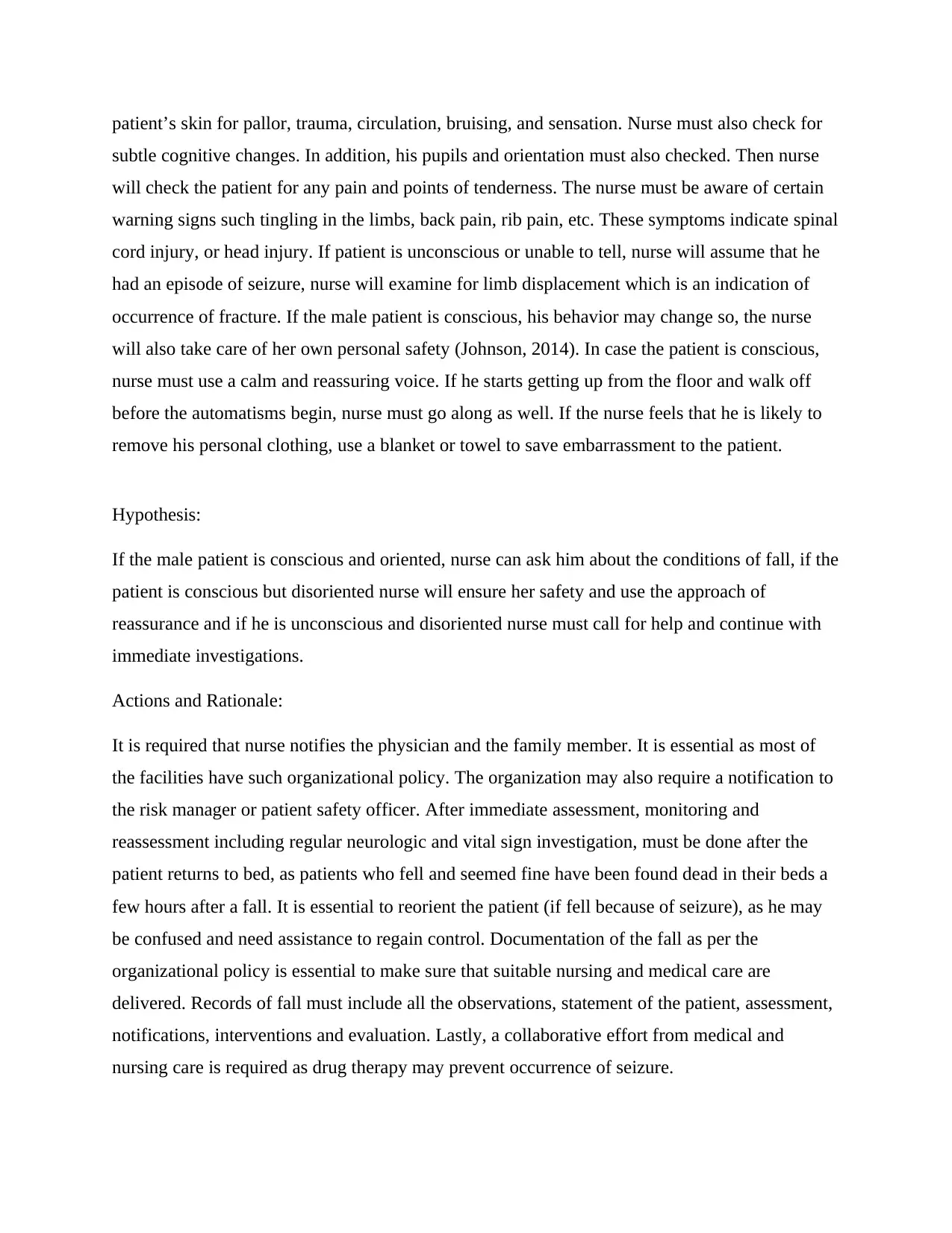
patient’s skin for pallor, trauma, circulation, bruising, and sensation. Nurse must also check for
subtle cognitive changes. In addition, his pupils and orientation must also checked. Then nurse
will check the patient for any pain and points of tenderness. The nurse must be aware of certain
warning signs such tingling in the limbs, back pain, rib pain, etc. These symptoms indicate spinal
cord injury, or head injury. If patient is unconscious or unable to tell, nurse will assume that he
had an episode of seizure, nurse will examine for limb displacement which is an indication of
occurrence of fracture. If the male patient is conscious, his behavior may change so, the nurse
will also take care of her own personal safety (Johnson, 2014). In case the patient is conscious,
nurse must use a calm and reassuring voice. If he starts getting up from the floor and walk off
before the automatisms begin, nurse must go along as well. If the nurse feels that he is likely to
remove his personal clothing, use a blanket or towel to save embarrassment to the patient.
Hypothesis:
If the male patient is conscious and oriented, nurse can ask him about the conditions of fall, if the
patient is conscious but disoriented nurse will ensure her safety and use the approach of
reassurance and if he is unconscious and disoriented nurse must call for help and continue with
immediate investigations.
Actions and Rationale:
It is required that nurse notifies the physician and the family member. It is essential as most of
the facilities have such organizational policy. The organization may also require a notification to
the risk manager or patient safety officer. After immediate assessment, monitoring and
reassessment including regular neurologic and vital sign investigation, must be done after the
patient returns to bed, as patients who fell and seemed fine have been found dead in their beds a
few hours after a fall. It is essential to reorient the patient (if fell because of seizure), as he may
be confused and need assistance to regain control. Documentation of the fall as per the
organizational policy is essential to make sure that suitable nursing and medical care are
delivered. Records of fall must include all the observations, statement of the patient, assessment,
notifications, interventions and evaluation. Lastly, a collaborative effort from medical and
nursing care is required as drug therapy may prevent occurrence of seizure.
subtle cognitive changes. In addition, his pupils and orientation must also checked. Then nurse
will check the patient for any pain and points of tenderness. The nurse must be aware of certain
warning signs such tingling in the limbs, back pain, rib pain, etc. These symptoms indicate spinal
cord injury, or head injury. If patient is unconscious or unable to tell, nurse will assume that he
had an episode of seizure, nurse will examine for limb displacement which is an indication of
occurrence of fracture. If the male patient is conscious, his behavior may change so, the nurse
will also take care of her own personal safety (Johnson, 2014). In case the patient is conscious,
nurse must use a calm and reassuring voice. If he starts getting up from the floor and walk off
before the automatisms begin, nurse must go along as well. If the nurse feels that he is likely to
remove his personal clothing, use a blanket or towel to save embarrassment to the patient.
Hypothesis:
If the male patient is conscious and oriented, nurse can ask him about the conditions of fall, if the
patient is conscious but disoriented nurse will ensure her safety and use the approach of
reassurance and if he is unconscious and disoriented nurse must call for help and continue with
immediate investigations.
Actions and Rationale:
It is required that nurse notifies the physician and the family member. It is essential as most of
the facilities have such organizational policy. The organization may also require a notification to
the risk manager or patient safety officer. After immediate assessment, monitoring and
reassessment including regular neurologic and vital sign investigation, must be done after the
patient returns to bed, as patients who fell and seemed fine have been found dead in their beds a
few hours after a fall. It is essential to reorient the patient (if fell because of seizure), as he may
be confused and need assistance to regain control. Documentation of the fall as per the
organizational policy is essential to make sure that suitable nursing and medical care are
delivered. Records of fall must include all the observations, statement of the patient, assessment,
notifications, interventions and evaluation. Lastly, a collaborative effort from medical and
nursing care is required as drug therapy may prevent occurrence of seizure.
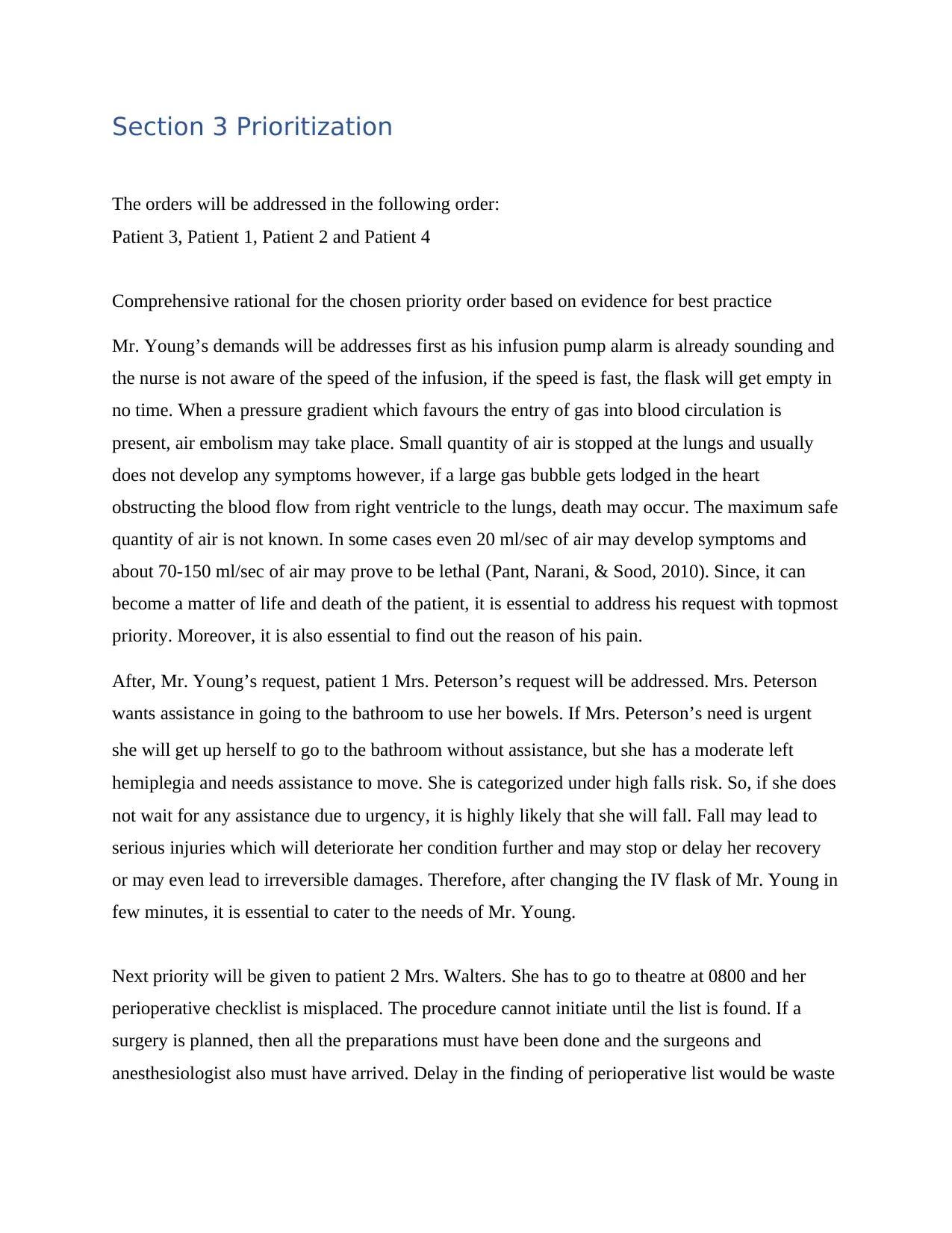
Section 3 Prioritization
The orders will be addressed in the following order:
Patient 3, Patient 1, Patient 2 and Patient 4
Comprehensive rational for the chosen priority order based on evidence for best practice
Mr. Young’s demands will be addresses first as his infusion pump alarm is already sounding and
the nurse is not aware of the speed of the infusion, if the speed is fast, the flask will get empty in
no time. When a pressure gradient which favours the entry of gas into blood circulation is
present, air embolism may take place. Small quantity of air is stopped at the lungs and usually
does not develop any symptoms however, if a large gas bubble gets lodged in the heart
obstructing the blood flow from right ventricle to the lungs, death may occur. The maximum safe
quantity of air is not known. In some cases even 20 ml/sec of air may develop symptoms and
about 70-150 ml/sec of air may prove to be lethal (Pant, Narani, & Sood, 2010). Since, it can
become a matter of life and death of the patient, it is essential to address his request with topmost
priority. Moreover, it is also essential to find out the reason of his pain.
After, Mr. Young’s request, patient 1 Mrs. Peterson’s request will be addressed. Mrs. Peterson
wants assistance in going to the bathroom to use her bowels. If Mrs. Peterson’s need is urgent
she will get up herself to go to the bathroom without assistance, but she has a moderate left
hemiplegia and needs assistance to move. She is categorized under high falls risk. So, if she does
not wait for any assistance due to urgency, it is highly likely that she will fall. Fall may lead to
serious injuries which will deteriorate her condition further and may stop or delay her recovery
or may even lead to irreversible damages. Therefore, after changing the IV flask of Mr. Young in
few minutes, it is essential to cater to the needs of Mr. Young.
Next priority will be given to patient 2 Mrs. Walters. She has to go to theatre at 0800 and her
perioperative checklist is misplaced. The procedure cannot initiate until the list is found. If a
surgery is planned, then all the preparations must have been done and the surgeons and
anesthesiologist also must have arrived. Delay in the finding of perioperative list would be waste
The orders will be addressed in the following order:
Patient 3, Patient 1, Patient 2 and Patient 4
Comprehensive rational for the chosen priority order based on evidence for best practice
Mr. Young’s demands will be addresses first as his infusion pump alarm is already sounding and
the nurse is not aware of the speed of the infusion, if the speed is fast, the flask will get empty in
no time. When a pressure gradient which favours the entry of gas into blood circulation is
present, air embolism may take place. Small quantity of air is stopped at the lungs and usually
does not develop any symptoms however, if a large gas bubble gets lodged in the heart
obstructing the blood flow from right ventricle to the lungs, death may occur. The maximum safe
quantity of air is not known. In some cases even 20 ml/sec of air may develop symptoms and
about 70-150 ml/sec of air may prove to be lethal (Pant, Narani, & Sood, 2010). Since, it can
become a matter of life and death of the patient, it is essential to address his request with topmost
priority. Moreover, it is also essential to find out the reason of his pain.
After, Mr. Young’s request, patient 1 Mrs. Peterson’s request will be addressed. Mrs. Peterson
wants assistance in going to the bathroom to use her bowels. If Mrs. Peterson’s need is urgent
she will get up herself to go to the bathroom without assistance, but she has a moderate left
hemiplegia and needs assistance to move. She is categorized under high falls risk. So, if she does
not wait for any assistance due to urgency, it is highly likely that she will fall. Fall may lead to
serious injuries which will deteriorate her condition further and may stop or delay her recovery
or may even lead to irreversible damages. Therefore, after changing the IV flask of Mr. Young in
few minutes, it is essential to cater to the needs of Mr. Young.
Next priority will be given to patient 2 Mrs. Walters. She has to go to theatre at 0800 and her
perioperative checklist is misplaced. The procedure cannot initiate until the list is found. If a
surgery is planned, then all the preparations must have been done and the surgeons and
anesthesiologist also must have arrived. Delay in the finding of perioperative list would be waste
⊘ This is a preview!⊘
Do you want full access?
Subscribe today to unlock all pages.

Trusted by 1+ million students worldwide
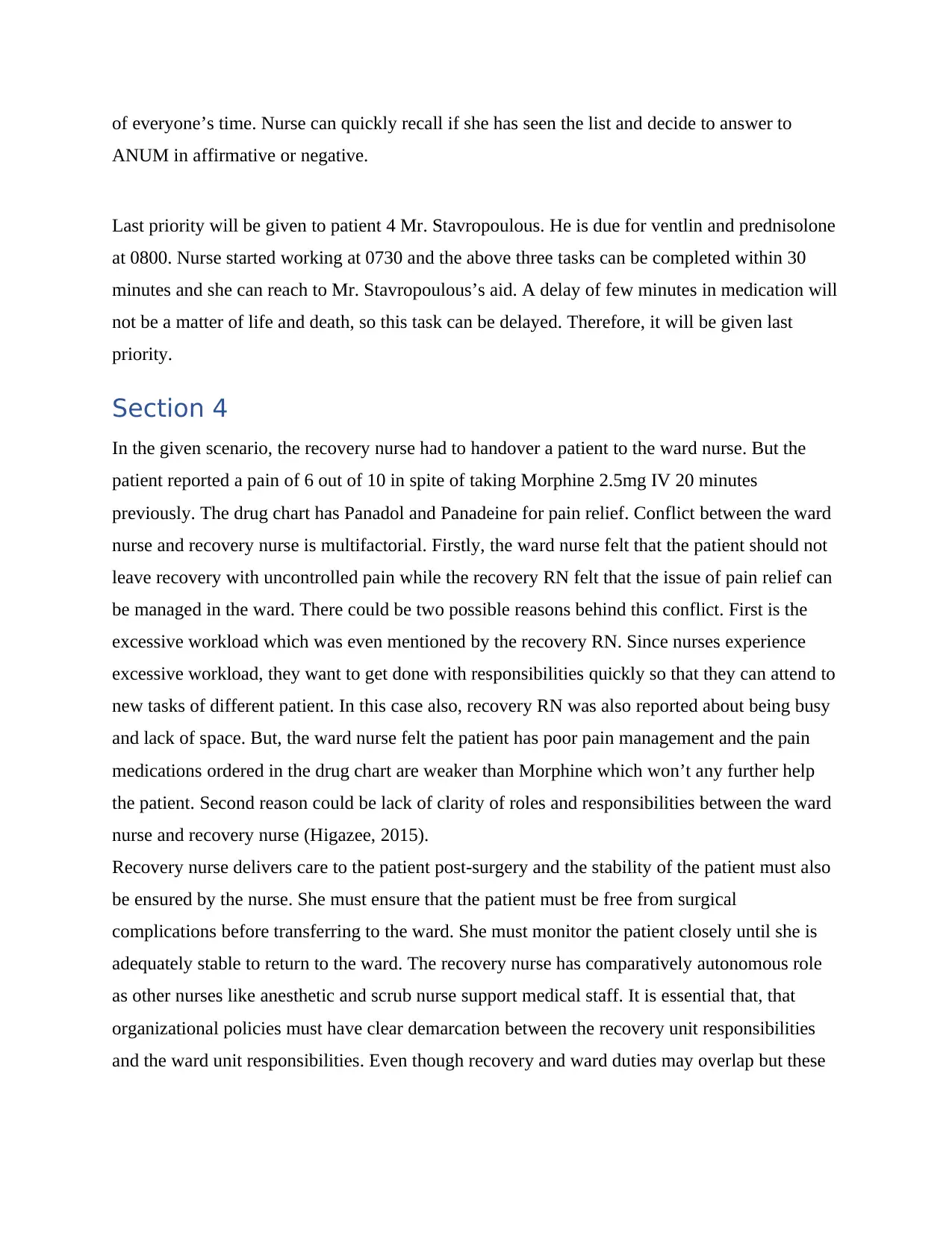
of everyone’s time. Nurse can quickly recall if she has seen the list and decide to answer to
ANUM in affirmative or negative.
Last priority will be given to patient 4 Mr. Stavropoulous. He is due for ventlin and prednisolone
at 0800. Nurse started working at 0730 and the above three tasks can be completed within 30
minutes and she can reach to Mr. Stavropoulous’s aid. A delay of few minutes in medication will
not be a matter of life and death, so this task can be delayed. Therefore, it will be given last
priority.
Section 4
In the given scenario, the recovery nurse had to handover a patient to the ward nurse. But the
patient reported a pain of 6 out of 10 in spite of taking Morphine 2.5mg IV 20 minutes
previously. The drug chart has Panadol and Panadeine for pain relief. Conflict between the ward
nurse and recovery nurse is multifactorial. Firstly, the ward nurse felt that the patient should not
leave recovery with uncontrolled pain while the recovery RN felt that the issue of pain relief can
be managed in the ward. There could be two possible reasons behind this conflict. First is the
excessive workload which was even mentioned by the recovery RN. Since nurses experience
excessive workload, they want to get done with responsibilities quickly so that they can attend to
new tasks of different patient. In this case also, recovery RN was also reported about being busy
and lack of space. But, the ward nurse felt the patient has poor pain management and the pain
medications ordered in the drug chart are weaker than Morphine which won’t any further help
the patient. Second reason could be lack of clarity of roles and responsibilities between the ward
nurse and recovery nurse (Higazee, 2015).
Recovery nurse delivers care to the patient post-surgery and the stability of the patient must also
be ensured by the nurse. She must ensure that the patient must be free from surgical
complications before transferring to the ward. She must monitor the patient closely until she is
adequately stable to return to the ward. The recovery nurse has comparatively autonomous role
as other nurses like anesthetic and scrub nurse support medical staff. It is essential that, that
organizational policies must have clear demarcation between the recovery unit responsibilities
and the ward unit responsibilities. Even though recovery and ward duties may overlap but these
ANUM in affirmative or negative.
Last priority will be given to patient 4 Mr. Stavropoulous. He is due for ventlin and prednisolone
at 0800. Nurse started working at 0730 and the above three tasks can be completed within 30
minutes and she can reach to Mr. Stavropoulous’s aid. A delay of few minutes in medication will
not be a matter of life and death, so this task can be delayed. Therefore, it will be given last
priority.
Section 4
In the given scenario, the recovery nurse had to handover a patient to the ward nurse. But the
patient reported a pain of 6 out of 10 in spite of taking Morphine 2.5mg IV 20 minutes
previously. The drug chart has Panadol and Panadeine for pain relief. Conflict between the ward
nurse and recovery nurse is multifactorial. Firstly, the ward nurse felt that the patient should not
leave recovery with uncontrolled pain while the recovery RN felt that the issue of pain relief can
be managed in the ward. There could be two possible reasons behind this conflict. First is the
excessive workload which was even mentioned by the recovery RN. Since nurses experience
excessive workload, they want to get done with responsibilities quickly so that they can attend to
new tasks of different patient. In this case also, recovery RN was also reported about being busy
and lack of space. But, the ward nurse felt the patient has poor pain management and the pain
medications ordered in the drug chart are weaker than Morphine which won’t any further help
the patient. Second reason could be lack of clarity of roles and responsibilities between the ward
nurse and recovery nurse (Higazee, 2015).
Recovery nurse delivers care to the patient post-surgery and the stability of the patient must also
be ensured by the nurse. She must ensure that the patient must be free from surgical
complications before transferring to the ward. She must monitor the patient closely until she is
adequately stable to return to the ward. The recovery nurse has comparatively autonomous role
as other nurses like anesthetic and scrub nurse support medical staff. It is essential that, that
organizational policies must have clear demarcation between the recovery unit responsibilities
and the ward unit responsibilities. Even though recovery and ward duties may overlap but these
Paraphrase This Document
Need a fresh take? Get an instant paraphrase of this document with our AI Paraphraser
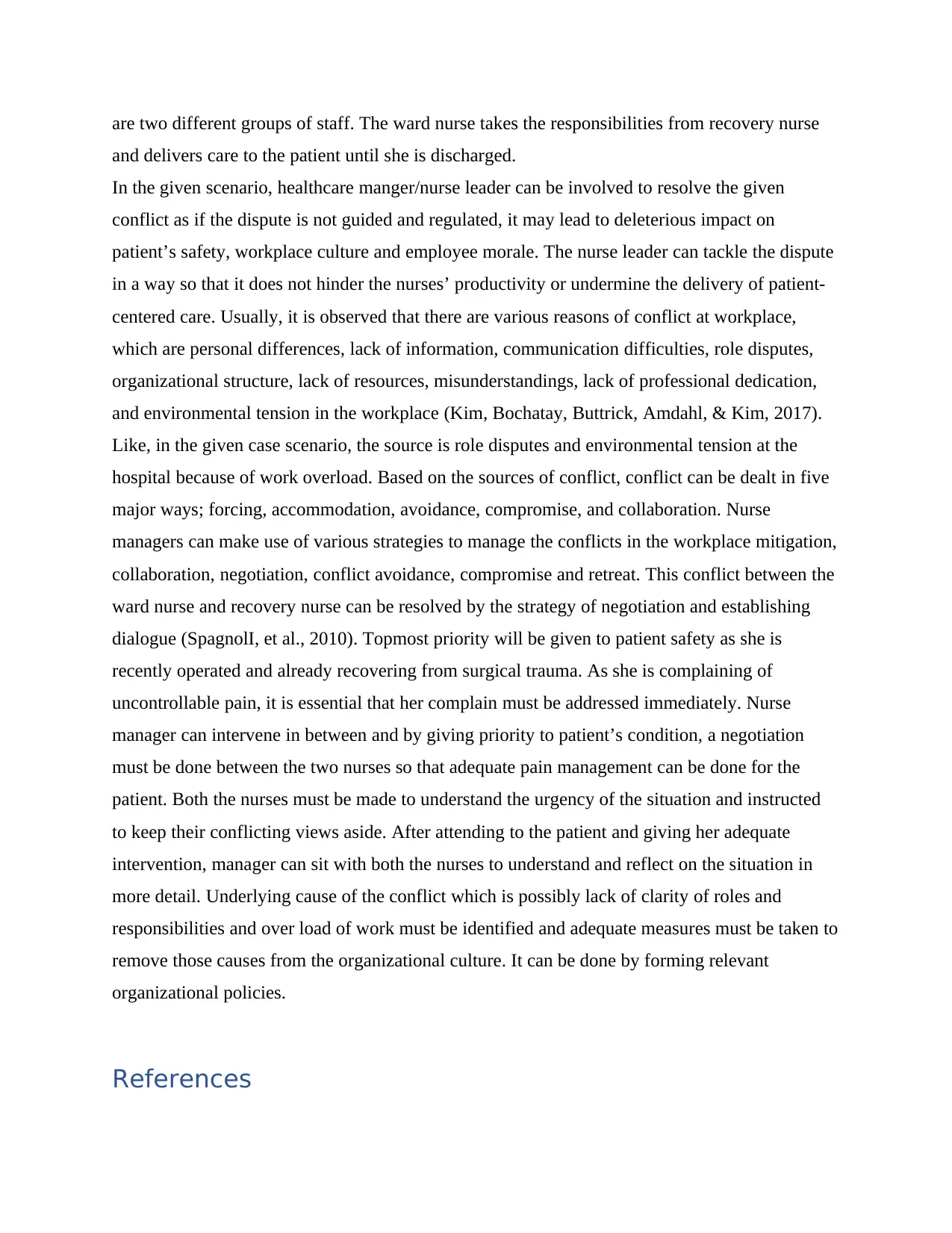
are two different groups of staff. The ward nurse takes the responsibilities from recovery nurse
and delivers care to the patient until she is discharged.
In the given scenario, healthcare manger/nurse leader can be involved to resolve the given
conflict as if the dispute is not guided and regulated, it may lead to deleterious impact on
patient’s safety, workplace culture and employee morale. The nurse leader can tackle the dispute
in a way so that it does not hinder the nurses’ productivity or undermine the delivery of patient-
centered care. Usually, it is observed that there are various reasons of conflict at workplace,
which are personal differences, lack of information, communication difficulties, role disputes,
organizational structure, lack of resources, misunderstandings, lack of professional dedication,
and environmental tension in the workplace (Kim, Bochatay, Buttrick, Amdahl, & Kim, 2017).
Like, in the given case scenario, the source is role disputes and environmental tension at the
hospital because of work overload. Based on the sources of conflict, conflict can be dealt in five
major ways; forcing, accommodation, avoidance, compromise, and collaboration. Nurse
managers can make use of various strategies to manage the conflicts in the workplace mitigation,
collaboration, negotiation, conflict avoidance, compromise and retreat. This conflict between the
ward nurse and recovery nurse can be resolved by the strategy of negotiation and establishing
dialogue (SpagnolI, et al., 2010). Topmost priority will be given to patient safety as she is
recently operated and already recovering from surgical trauma. As she is complaining of
uncontrollable pain, it is essential that her complain must be addressed immediately. Nurse
manager can intervene in between and by giving priority to patient’s condition, a negotiation
must be done between the two nurses so that adequate pain management can be done for the
patient. Both the nurses must be made to understand the urgency of the situation and instructed
to keep their conflicting views aside. After attending to the patient and giving her adequate
intervention, manager can sit with both the nurses to understand and reflect on the situation in
more detail. Underlying cause of the conflict which is possibly lack of clarity of roles and
responsibilities and over load of work must be identified and adequate measures must be taken to
remove those causes from the organizational culture. It can be done by forming relevant
organizational policies.
References
and delivers care to the patient until she is discharged.
In the given scenario, healthcare manger/nurse leader can be involved to resolve the given
conflict as if the dispute is not guided and regulated, it may lead to deleterious impact on
patient’s safety, workplace culture and employee morale. The nurse leader can tackle the dispute
in a way so that it does not hinder the nurses’ productivity or undermine the delivery of patient-
centered care. Usually, it is observed that there are various reasons of conflict at workplace,
which are personal differences, lack of information, communication difficulties, role disputes,
organizational structure, lack of resources, misunderstandings, lack of professional dedication,
and environmental tension in the workplace (Kim, Bochatay, Buttrick, Amdahl, & Kim, 2017).
Like, in the given case scenario, the source is role disputes and environmental tension at the
hospital because of work overload. Based on the sources of conflict, conflict can be dealt in five
major ways; forcing, accommodation, avoidance, compromise, and collaboration. Nurse
managers can make use of various strategies to manage the conflicts in the workplace mitigation,
collaboration, negotiation, conflict avoidance, compromise and retreat. This conflict between the
ward nurse and recovery nurse can be resolved by the strategy of negotiation and establishing
dialogue (SpagnolI, et al., 2010). Topmost priority will be given to patient safety as she is
recently operated and already recovering from surgical trauma. As she is complaining of
uncontrollable pain, it is essential that her complain must be addressed immediately. Nurse
manager can intervene in between and by giving priority to patient’s condition, a negotiation
must be done between the two nurses so that adequate pain management can be done for the
patient. Both the nurses must be made to understand the urgency of the situation and instructed
to keep their conflicting views aside. After attending to the patient and giving her adequate
intervention, manager can sit with both the nurses to understand and reflect on the situation in
more detail. Underlying cause of the conflict which is possibly lack of clarity of roles and
responsibilities and over load of work must be identified and adequate measures must be taken to
remove those causes from the organizational culture. It can be done by forming relevant
organizational policies.
References
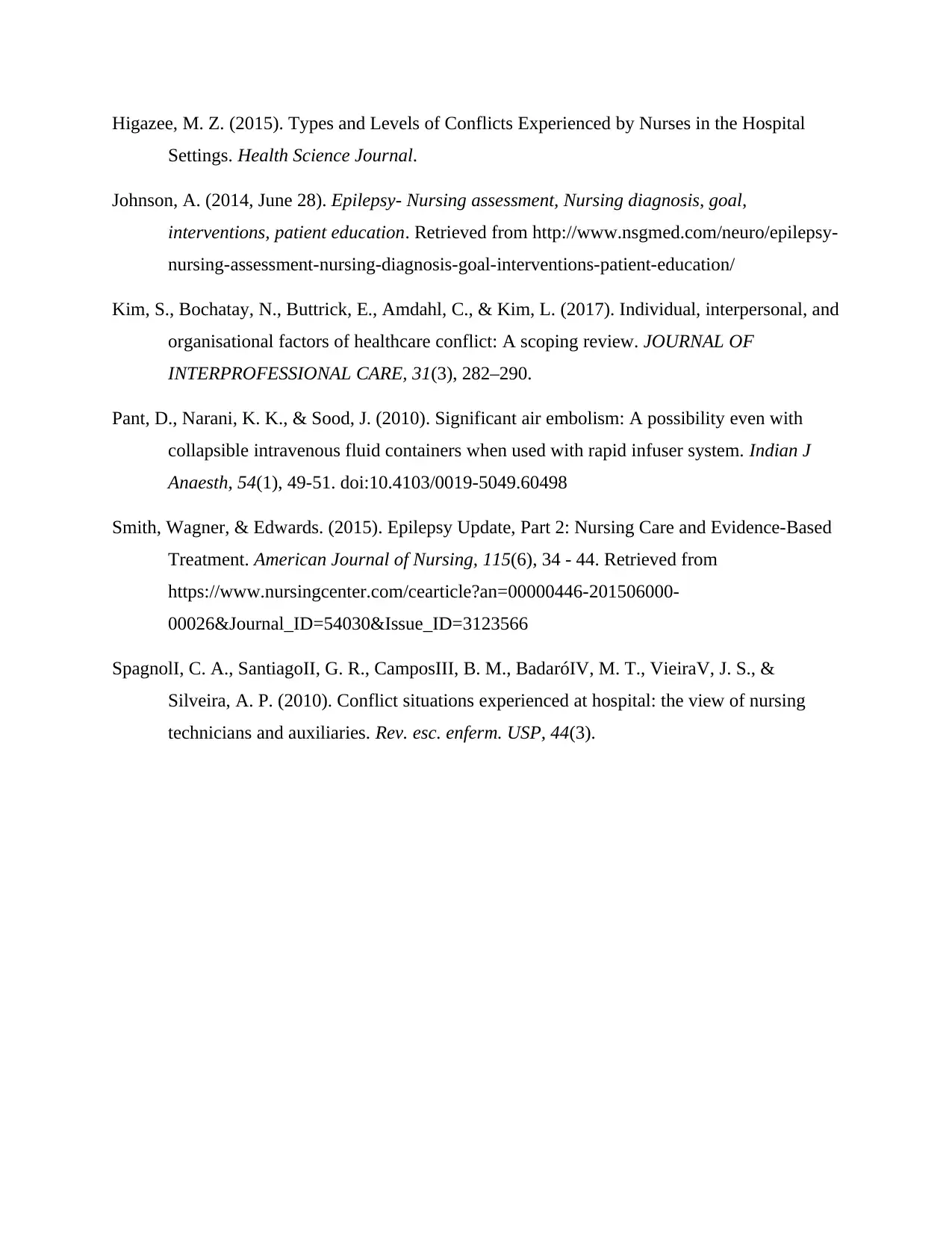
Higazee, M. Z. (2015). Types and Levels of Conflicts Experienced by Nurses in the Hospital
Settings. Health Science Journal.
Johnson, A. (2014, June 28). Epilepsy- Nursing assessment, Nursing diagnosis, goal,
interventions, patient education. Retrieved from http://www.nsgmed.com/neuro/epilepsy-
nursing-assessment-nursing-diagnosis-goal-interventions-patient-education/
Kim, S., Bochatay, N., Buttrick, E., Amdahl, C., & Kim, L. (2017). Individual, interpersonal, and
organisational factors of healthcare conflict: A scoping review. JOURNAL OF
INTERPROFESSIONAL CARE, 31(3), 282–290.
Pant, D., Narani, K. K., & Sood, J. (2010). Significant air embolism: A possibility even with
collapsible intravenous fluid containers when used with rapid infuser system. Indian J
Anaesth, 54(1), 49-51. doi:10.4103/0019-5049.60498
Smith, Wagner, & Edwards. (2015). Epilepsy Update, Part 2: Nursing Care and Evidence-Based
Treatment. American Journal of Nursing, 115(6), 34 - 44. Retrieved from
https://www.nursingcenter.com/cearticle?an=00000446-201506000-
00026&Journal_ID=54030&Issue_ID=3123566
SpagnolI, C. A., SantiagoII, G. R., CamposIII, B. M., BadaróIV, M. T., VieiraV, J. S., &
Silveira, A. P. (2010). Conflict situations experienced at hospital: the view of nursing
technicians and auxiliaries. Rev. esc. enferm. USP, 44(3).
Settings. Health Science Journal.
Johnson, A. (2014, June 28). Epilepsy- Nursing assessment, Nursing diagnosis, goal,
interventions, patient education. Retrieved from http://www.nsgmed.com/neuro/epilepsy-
nursing-assessment-nursing-diagnosis-goal-interventions-patient-education/
Kim, S., Bochatay, N., Buttrick, E., Amdahl, C., & Kim, L. (2017). Individual, interpersonal, and
organisational factors of healthcare conflict: A scoping review. JOURNAL OF
INTERPROFESSIONAL CARE, 31(3), 282–290.
Pant, D., Narani, K. K., & Sood, J. (2010). Significant air embolism: A possibility even with
collapsible intravenous fluid containers when used with rapid infuser system. Indian J
Anaesth, 54(1), 49-51. doi:10.4103/0019-5049.60498
Smith, Wagner, & Edwards. (2015). Epilepsy Update, Part 2: Nursing Care and Evidence-Based
Treatment. American Journal of Nursing, 115(6), 34 - 44. Retrieved from
https://www.nursingcenter.com/cearticle?an=00000446-201506000-
00026&Journal_ID=54030&Issue_ID=3123566
SpagnolI, C. A., SantiagoII, G. R., CamposIII, B. M., BadaróIV, M. T., VieiraV, J. S., &
Silveira, A. P. (2010). Conflict situations experienced at hospital: the view of nursing
technicians and auxiliaries. Rev. esc. enferm. USP, 44(3).
⊘ This is a preview!⊘
Do you want full access?
Subscribe today to unlock all pages.

Trusted by 1+ million students worldwide
1 out of 6
Related Documents
Your All-in-One AI-Powered Toolkit for Academic Success.
+13062052269
info@desklib.com
Available 24*7 on WhatsApp / Email
![[object Object]](/_next/static/media/star-bottom.7253800d.svg)
Unlock your academic potential
Copyright © 2020–2025 A2Z Services. All Rights Reserved. Developed and managed by ZUCOL.




